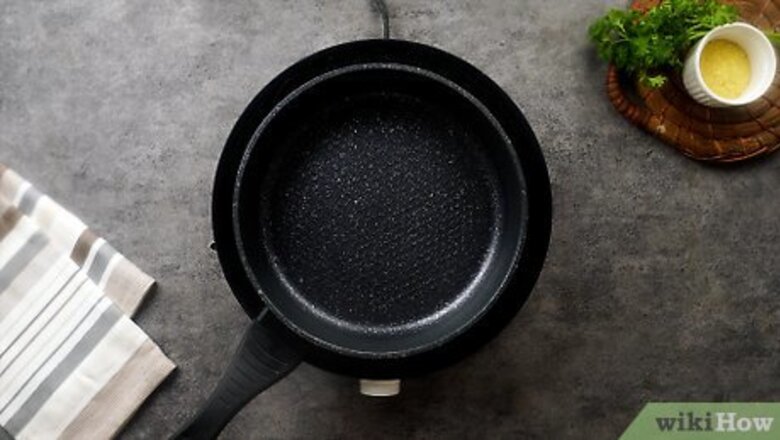
views
X
Research source
While there is a little trick you can try with dry instant yeast, keep in mind that there’s no way to make sure all the yeast has been deactivated. Eating activated yeast can cause bloating and other gastrointestinal issues, so you’re better off purchasing nutritional yeast from a grocery store or reputable supplier.[2]
X
Trustworthy Source
PubMed Central
Journal archive from the U.S. National Institutes of Health
Go to source
Deactivating Dry Instant Yeast
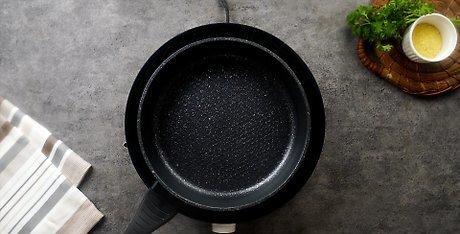
Heat a medium to large skillet on medium-high heat. Use a skillet that’s large enough to ensure each granule of instant yeast gets heated evenly. You can use a stainless steel, coated cast iron, or nonstick pan. Avoid using a non-coated cast iron pan because those typically need oil to avoid sticking.
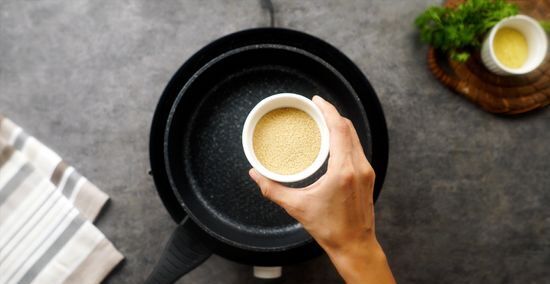
Place your instant yeast into the skillet. Sprinkle the yeast evenly into the heated pan. You can use any amount of instant yeast as long as the pan is large enough to ensure each granule gets the same exposure to heat. Most active dry yeast packets contain about 7 grams each, so if you want to make 1/4 cup of nutritional yeast, pour 6 or 7 packets of active instant yeast into a measuring cup until you have a full 1/4 cup (32 grams). Then, sprinkle the yeast evenly into the heated pan.
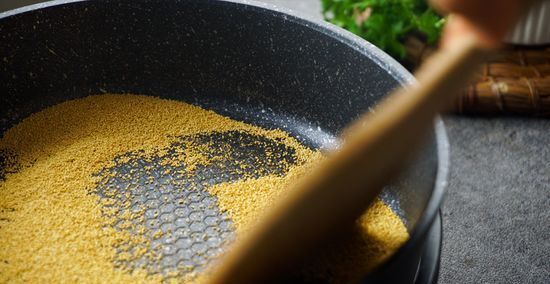
Heat the yeast granules on medium to high heat until evenly browned. Use a spoon or spatula to move the yeast granules around in the pan as they heat up. Make sure to scrape the sides of the pan so every granule has the same exposure to heat. It could take anywhere from 2 to 5 minutes to deactivate the yeast. The yeast is done when each granule has turned a medium golden brown color.
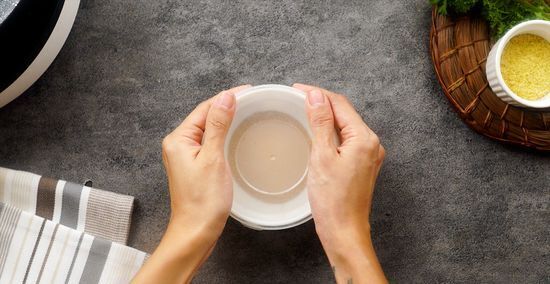
Let it cool and transfer it to an airtight container. Remove the pan from heat and let the granules cool down. Once it’s cool to the touch, transfer the yeast granules into an airtight plastic container or zipper bag. Store the bag or container in a cool, dry place. Note that there’s no way to know if the yeast is fully deactivated, so eat it at your own risk!
Using Nutritional Yeast
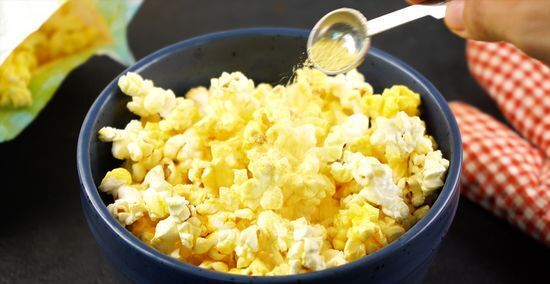
Sprinkle it on popcorn in place of salt. If you’re trying to avoid sodium, nutritional yeast is the perfect popcorn topper. Use about 1 tablespoon (15 grams) for every 2 to 3 cups (256 to 384 grams) of popcorn. It will add a nice, cheesy flavor and give you a boost of vitamin B12. Nutritional yeast has no sodium, so it's a great alternative if you typically sprinkle salt on popcorn. Not all brands are fortified with B12, so be sure to check the label. Each tablespoon (15 grams) of nutritional yeast has 5 mcg of B12—that’s a little more than twice the daily recommended amount!
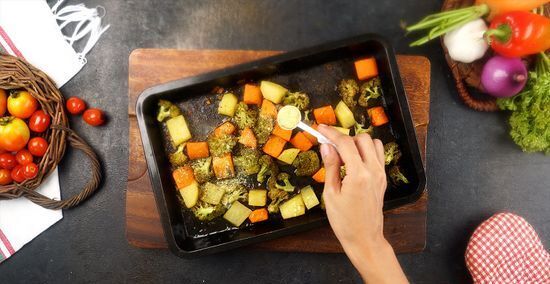
Toss it on roasted vegetables for an umami taste. Sprinkle 1 to 3 tablespoons (15 to 45 grams) of nutritional yeast on your favorite cooked veggies to add a savory, umami flavor. Nutritional yeast tastes great with roasted carrots, potatoes, greens, squash, broccoli, cauliflower, and just about any other veggie! You can sprinkle nutritional yeast on raw vegetables too, but the flakes might not stick to them as well.
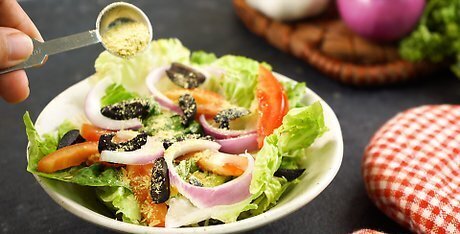
Use nutritional yeast to add a cheesy flavor to leafy green salads. Toss your salads with about 1 tablespoon (15 grams) of nutritional yeast in place of cheese. This works especially well for dairy-free or vegan versions of caesar or cobb salads. If you’ve overdressed your salad and don’t have any more greens to disperse the dressing, adding some nutritional yeast can help soak up some of the moisture. Just note that it may create a powdery texture.

Replace cheese with nutritional yeast in pasta and rice dishes. If you’re avoiding or cutting back on dairy, use nutritional yeast for all your cheesy dishes. Use about 1/4 cup (32 grams) to cheese-up pasta noodles, rice bowls, and casseroles. Note that the cheesy taste of nutritional yeast may be overpowered by tomato sauce.
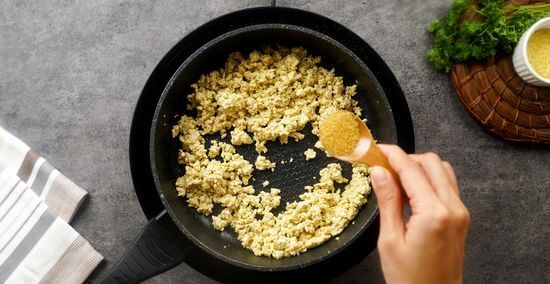
Make a vegan tofu scramble with nutritional yeast for a savory kick. Use anywhere from 2 tablespoons (30 grams) to 1/4 cup (32 grams) of nutritional yeast per half or full package of tofu. It will make your scramble taste light, fluffy, and cheesy. You can also sprinkle it on regular egg scrambles in in place of cheese.

Thicken soups and stews with nutritional yeast. Use about 1/2 cup (64 grams) of nutritional yeast for every 1 cup (240 mL) of liquid in your soup. Simply stir in a spoonful at a time until the soup reaches your desired consistency. Keep in mind that nutritional yeast will slightly change the flavor of the soup, so if that’s an issue, you might stick to using starch or flour. This will also work for gravies and other sauces.

Make a vegan cheese sauce with nutritional yeast for dipping and drizzling. Whisk together 1/4 cup (32 grams) of tahini, 2 tablespoons (30 grams) of nutritional yeast, 2 tablespoons (30 mL) of lemon juice, 2 tablespoons (30 grams) of white miso, and ⁄2 cup (120 mL) to ⁄3 cup (160 mL) of water. Microwave the mixture for about 1 minute and then whisk it again before using it. Sprinkle in some onion powder, rosemary, thyme, or other spices and herbs to suit your tastes. Add spinach, broccoli, artichoke hearts, black beans, or any other extras you like in your dips. Use the cheese sauce as a fondue or drizzle it over grains, tacos, enchiladas, and proteins as a healthier alternative to melted cheese.
















Comments
0 comment